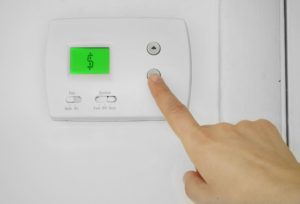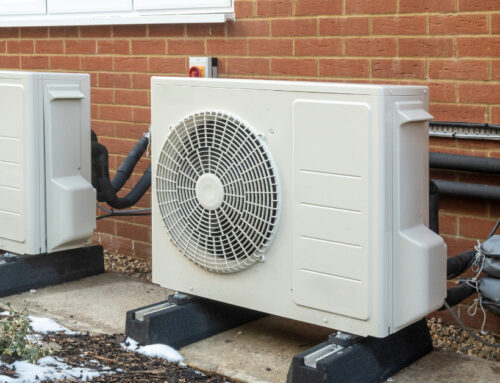Ask Dirk: What is the best thermostat for my home?

Heating can account for nearly half of the average family’s winter energy bill, according to the U.S. Department of Energy. Having a good thermostat may help homeowners reduce those costs. The market is full of choices when it comes to home thermostats, so let’s break it down so that you as the homeowner can make an informed decision before winter hits here in northern Nevada.
High-end thermostat options:
Smart thermostats
Operates like a programmable thermostat, but allows the user to access the system from any internet-connect device, including a smartphone, which allows the user to adjust the temperature remotely. Some smart thermostats will let you manage temperature, humidity, air quality, fan speeds, ventilation, and zoning, making it easy for you to create your comfort settings and connect with your system while home or away.
These thermostats know the temperature outside and adjust the inside temperature, based on your known settings. Automatically.
Care should be taken to make sure your smart thermostat is programmed correctly to ensure the best energy savings. These systems also have the capacity to record the inside and outside temperature, notify the homeowner when the filter should be changed, and record its own operating time.
Learning thermostats
The next evolution in smart thermostats is the learning thermostat, which can “learn” when the home is likely to be occupied or empty, thus allowing for automatic heating and cooling upon entry. They do this by using motion detectors to determine when the home is occupied or by using a wireless network to sense when someone is away from their home.
Some manufacturers claim this new breed of comfort management device can save homeowners an average of 20% on their heating and cooling energy costs. Combine that with custom energy tips and you can make informed decisions about when and how to save even more money.
I’m not yet a fan of learning thermostats. I think they work well if you have regular patterns and don’t want to bother with programming your thermostat, but they aren’t great at unusual patterns. I tried one at my office. It noticed that I came in on a couple of Saturdays, so it started turning up the heat every Saturday whether I was there or not. It also started turning on for my cleaning crew who left the door open while they were working. I’ve switched back to a programmable thermostat with Wi-Fi. Now if I’m headed into the office on the weekend, I can set the thermostat when I leave home.
Mid-range thermostat options:
Programmable thermostats
Allows the operator to set back the temperature based on a schedule of your choosing, so you don’t have to set it back when you leave or turn in for the night. Once you manually set the desired temperatures for, say daytime and nighttime or weekdays and weekends, the system heats or cools the home to those desired setpoints automatically.
Budget-friendly options
Non-programmable thermostats
The most basic option allows the homeowner to turn on the heating or cooling, set the temperature, and operate the fan. Also known as manual thermostats, all functions in these systems are operated manually. Keeps the home at the same temperature 24 hours a day unless it is manually changed.
How to decide?
If you’re really excited about technology, the smart and learning thermostats are really fun. If all you want is comfort without thinking too much, programmable thermostats are a great option. Non-programmable thermostats are easy to use – no fuss, no muss.
Consider your budget and your appetite for learning, and, as I always say, do your research.
If you have a question or comment, I’d love to hear from you. Please send it to me at [email protected] and I’ll try to answer it in an upcoming column.
Here are a couple of questions I got recently from Philip L. regarding my recent blog post, “Is my thermostat costing me money?”
Q: Is there any truth to NV Energy manipulating your HVAC system with their installed thermostats?
A: Yes, in fact, NV Energy can control the set point in your home if you let them install their thermostat. See the following references:
- https://mynews4.com/news/local/nv-energy-offers-free-smart-thermostats-to-customers-but-will-increase-home-temperature
- https://www.nvenergy.com/save-with-powershift/smart-thermostat
Q: Were we to replace our 8+-year-old programmable thermostat, what would you recommend?
A: There are many options for replacement thermostats. It’s kind of like buying a car – it’s difficult for one person to decide what’s best for another. The way you want to use your system will largely decide what’s best for you:
- Are you looking for simplicity, and do you prefer to be in charge of the temperature that is set?
- Do you want to set a temperature program that runs every day?
- Do you want different programs on weekdays and weekends?
- Do you want a different program every day?
- Do you want to be able to control your temperature setting from your phone or tablet? (Even when you’re not home.)
- Do you want to use Alexa or Google Home to control your thermostat by voice?
- Do you want a thermostat that watches you and tries to program itself according to what it sees?
- Do you want a thermostat that can send you a text if it gets too cold in your home?
There are many options available to you, once you know your preferences. If you know what they are, I’d be happy to help you out!
— Dirk




